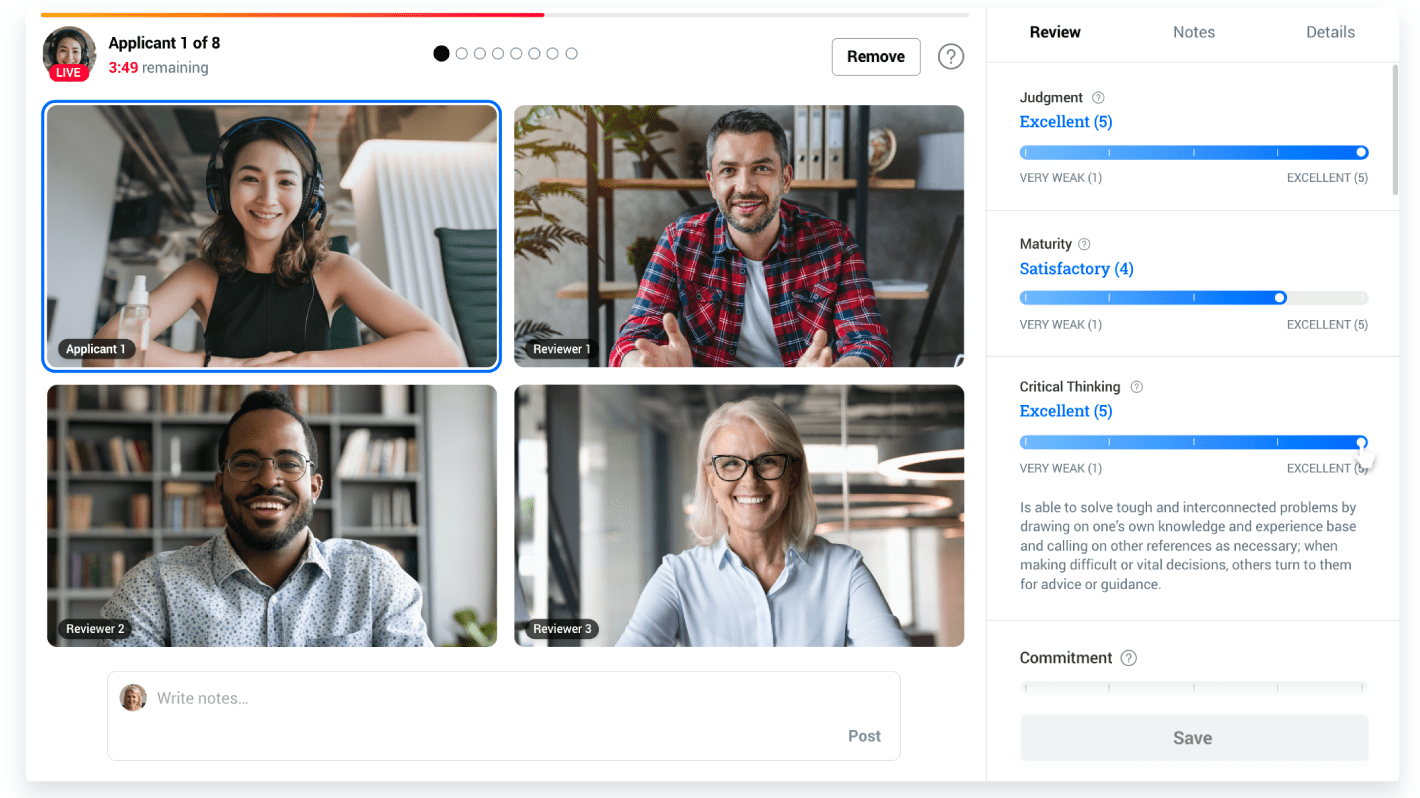We’ve rounded up 10 tips for you to keep in mind while you’re living out of a suitcase.
1. Bring your favorite water bottle, or invest in one
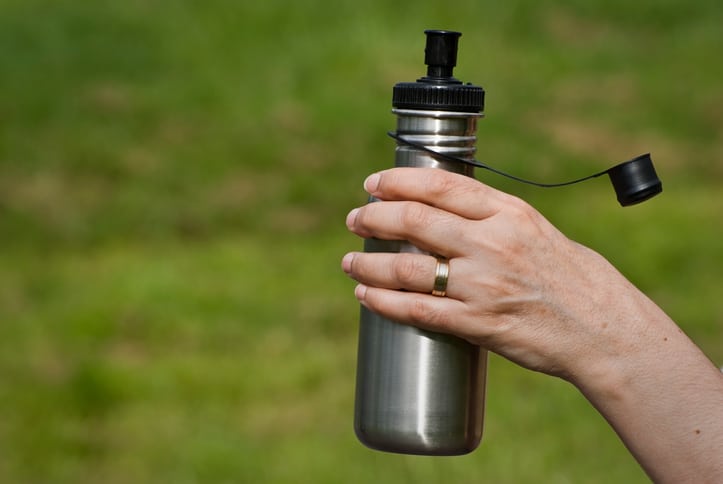
Carrying a reusable water bottle will help you continuously stay hydrated during your trip and is better for the environment than purchasing bottled water.
Hotels and conference centers often have purified water on hand you just need the receptacle.
Not a water bottle person? If you find and invest in a water bottle you actually like, you’ll be less likely to forget it and more likely to make a routine out of bringing it around with you. Your body, and your wallet, will appreciate the change.
Thirst can also be sometimes mistaken for hunger. Fun fact: The same part of your brain that is responsible for interpreting hunger signals is also responsible for interpreting thirst signals.
Did you know that even airplane air can be dehydrating? This is as a result of the lack of humidity in the cabin air. RN Marijke Vroomen-Durning explains that cabin air has the humidity level of 10 to 20 percent, much lower than the typical comfortable indoor humidity level of 30 to 65 percent. So instead of ordering a soda or a glass of wine on your flight, stick to water to feel the most refreshed.
As a rule of thumb, most experts recommend consuming 8 ounces of water per hour on a flight, as Vroomen-Durning notes, and 1 ounce for every pound of body weight during the day. Check out what your daily water intake target should be with this calculator.
2. Always be snacking

After airport lines, traffic delays, and arriving late to your hotel, it might be difficult and discouraging to find something healthy to eat when you are hungry. And to top it off, countries have varying regulations and restrictions when it comes to what food is permitted in your carry-on and even your checked baggage.
For international travel, plan ahead and find a nearby grocery store near your hotel or conference center and prepare snacks to keep your blood sugar stable throughout your trip.
Need ideas? We’ve compiled a list of healthy snack ideas for life on the road.
3. Stick to an exercise routine
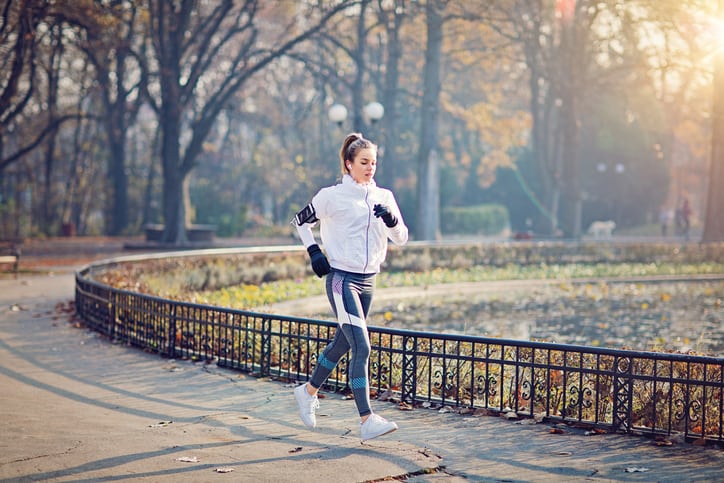
Regular exercise has been proven to reduce stress, ward off anxiety and feelings of depression, boost self-esteem, and improve sleep – all contributing factors to a successful and enjoyable recruitment season.
Just like packing your outfits and toiletries, also pack your workout clothes and a pair of running shoes. Even getting out for a 20-minute or 30-minute walk in the morning or evening while calling home or catching up with the daily news makes a different.
If you prefer to do laps in the hotel pool, consider bringing a swimsuit.
Don’t hesitate to ask the concierge to map out a close by scenic jogging or biking route.
Stick with the plans you made for yourself.
4. Find local classes to keep you motivated

If you are motivated by exercise classes, consider an app like ClassPass or MindbodyOnline to schedule classes in the cities you’ll be visiting. Make exercise the one constant in trips full of uncertainty.
Some hotels even offer complimentary classes. You might be pleasantly surprised to find something unique like rooftop yoga is offered in your hotel.
5. Augment exercise with entertainment
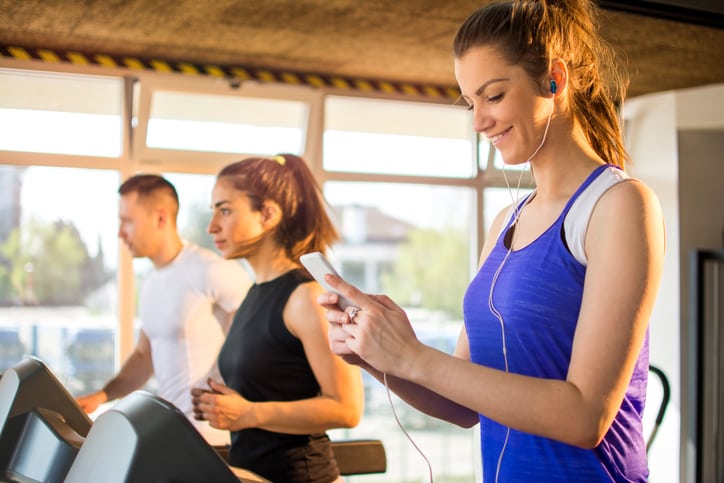
If you don’t want to participate in fitness classes, don’t fret.
You can find a podcast, TV show, or book that you can load on your phone or tablet and unwind by enjoying it on the bike in the hotel gym instead of in your room. Podcast apps and several popular streaming services like Netflix will allow you to download several of their titles to a smartphone or tablet while on a wireless connection, so you can load it up, even if the gym doesn't offer Wifi.
See: Downloading TV shows and movies on Netflix.
Combining entertainment and exercise can serve to hit two birds with one stone after a long day.
6. Book walking meetings

Another way of incorporating fitness during recruitment season is to go on walks for your meetings, also known as “walk and talk” meetings. It may not be a traditional way to chat with an applicant, but it might be a refreshing change from conference centers for both of you.
7. Avoid caffeine-heavy beverages before and during your flight

Caffeine-heavy beverages such as coffee, cola, and energy drinks will affect your ability to sleep and increase jet lag recovery time.
Your body functions best when it’s hydrated, so drinking lots of water is a great way to offset the effects of jet lag.
Free hot water is one of the few remaining in-flight freebies, so bring your own herbal tea bags.
8. Mentally-prepare for jet lag

When you get on the plane, set your watch to the time of your destination to get yourself psychologically aligned. Warning: Don’t do this too far beforehand, unless you want to end up with the world’s most ridiculous excuse for missing your flight.
Our circadian rhythms have evolved to be linked to the solar day, meaning our internal clock can be easily influenced by quantities and timings of daylight. A tip from experienced air travelers is to go out and get exposure to morning sunlight and take evening melatonin if you’re traveling east to fast-forward your body clock. As for traveling west, evening natural light and morning melatonin will help rewind your body clock.
9. Find ways to get outside

If you can't get walks into your day, having lunch or dinner outside in a park or on a patio is a good way of getting vitamin D. You can't get the right amount of vitamin D your body needs from food, and it can improve your mood, help with depression and aid in alleviating stress.
Last but certainly not least...
10. Find time for you

With all the hustle and bustle, make time to relax and enjoy yourself. Your mental health is as important, if not more important than your physical health while traveling. Read books, see shows, and don’t beat yourself over having a burger or taking it easy one night.
Everything in moderation, as they say!
Take it all in. Travel season will be over before you know it.
Traveling, in general, is hard on the body.
Take the combination of long flights and long drives with the stress and pressure of never-ending days of public speaking, selling your program, and engaging in conversations with hundreds of prospective students, then go talk to your doctor.
They’ll probably say: Slow down. You’re taking on too much.
But during the heat of recruitment season, that’s the last thing you (or your boss) wants you to do.
We’ve compiled a list of eight nutritious snack ideas that are easy to find and keep well for living out of a suitcase why these foods are a great choice, plus some tips for the inevitable cocktail hour.
Bon appetit!
Eight On-the-Go Snack Ideas
1. Fruits
Easy-to-eat fruits like apples, bananas, pears, blueberries, and grapes. They are important sources of many nutrients, including potassium, fiber, vitamin C and folate (folic acid) which are vital for the health and maintenance of the human body. Potassium in fruit reduces the risk of heart disease and stroke, and may also reduce the risk of developing kidney stones and help to decrease bone loss as you age. Folate (folic acid) helps the body form red blood cells.
2. Raw veggies
Raw veggies such as cherry tomatoes, carrot sticks, cucumber slices, and celery because they travel well. University of Washington’s Chris Vogliano suggests to also pair veggies with hummus which is packed with plant-based protein, additional fiber, and healthy fats that help keep you from feeling hungry.
3. Raw, unsalted seeds
Seeds like pumpkin or sunflower are excellent sources of antioxidant polyphenols and can help reduce the risk of certain diseases. In particular, the lignans in certain seeds may help lower cholesterol and the risk of cancer. Seeds are extremely easy to add to salads, yogurt, oatmeal, and smoothies, and can be a versatile way to add healthy nutrients to your diet.
4. Dried fruits
Dried fruits with no added sugars contain fiber and antioxidants called phenols. Fiber fights heart disease, obesity, and some types of cancer. People with diets rich in plant phenols have lower rates of heart disease, diabetes, several kinds of cancer, and possibly degenerative brain diseases.
Because of the high sugar content in dried fruits, they help boost your low blood sugar after a high dose of physical activity. But be careful when picking dried fruit. The Healthy Maven, a multi-channel health and wellness platform that helps women to live healthFULLY rather than living for their health, recommends finding sun-dried fruit that isn’t coated in sugar. It’s more expensive, but worth it in the long run.
5. Raw, unsalted nuts, like almonds
Unsalted nuts are a heart-healthy snack. Not only are almonds rich in the amino acid L-arginine, which helps build lean muscle and reduces belly fat, as found in a study published by The Journal of the International Society of Sports Nutrition, but they also contain the minerals riboflavin and manganese, which are essential for a healthy metabolism. In addition, most people don’t eat enough healthful unsaturated fats!
6. Low-sugar fruit, vegetable, oat or nut bars with whole food ingredients
Granola bars are the "Swiss Army knife of snacks." Reader’s Digest top nutritionists’ picks include Lara Bars, Zing Bars, and KIND Bars. My favorite KIND bar flavor is the Maple Glazed Pecan and Sea Salt which contains only 5g of sugar and 1.5g of saturated fats, and the taste is spot on!
7. Unsalted or lightly salted whole-grain pita chips, popcorn or crackers
Did you know that popcorn is the only snack that is 100% unprocessed whole grain? Just one serving contains more than 70% of the recommended daily whole grain intake. And even though cereals are labeled whole grains as well, that just means that more than half of the weight of those products is whole grain.
8. Homemade trail mix
Make your own trail mix by combining nuts, seeds, dried fruit, and a touch of your preferred sweetness, like dark chocolate or popcorn.
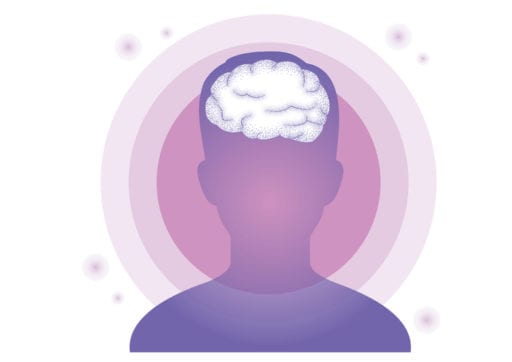 Looking for more general travel tips? Check out Ten Wellness Tips for Staying Healthy During Recruitment Season.
Looking for more general travel tips? Check out Ten Wellness Tips for Staying Healthy During Recruitment Season.
During my summer internship at Kira Talent, I had the opportunity to hear Dr. Ann Cavoukian speak on the topic of Privacy by Design in an Era of Artificial Intelligence at The Michener Institute of Education at University Health Network.
Dr. Cavoukian is Ontario’s longest standing Information and Privacy Commissioner, having served for three terms – 17 years after her appointment in 1997. Cavoukian’s background in psychology brought a successful new mindset and focus to the prevention of privacy issues within the Commissioner role.
Cavoukian is also well known for developing Privacy by Design, “A framework that seeks to proactively embed privacy into the design specifications of information technologies, networked infrastructure, and business practices, thereby achieving the strongest protection possible.”
Growing up as a millennial and, now as an undergraduate student at a Canadian university, I was curious to learn more about the relationship between privacy and technology. I’ve often wondered how my data is stored and protected, shared with other parties internally and externally, handled once I’ve graduated, and how this data could be used to everyone’s advantage.
Why is Privacy Important
“People want privacy more than ever,” Cavoukian insisted during her talk.
Public opinion polls consistently find that at least 90% of the population is very concerned about privacy, and their loss of control over their personal information, but don’t know how to regain control.
I’ve had a professor comment that my university’s course management system has become more and more invasive with each update. It tracks and surveils students’ online activity, such as when we sign on or off, all of our communication, what specific web pages, links, documents we view and download, the amount of time we spend on each web page, etc.
I wasn’t too surprised to hear this as it seems almost expected given how much we hear about surveillance and tracking. It did, however, make me more interested in my data security and the proactive measures I should be taking.
“Privacy is not about having something to hide … it’s about control and forms the foundation of our freedom” Cavoukian noted.
Privacy equals personal control. And with control, comes freedom of choice; data subjects, much like the students forced to use their university’s course management system, should be able to decide what information they would like shared, and to what extent. They deserve transparency, and a right to access as it is their information after all.
“Only the individual knows what is relevant and sensitive to them,” affirmed Cavoukian, and personal preferences vary between individuals.
Cavoukian said that Privacy by Design will truly benefit companies and organizations as well, because users “are the ones who will keep the information accurate and are the only ones who know, that what you have on file, is actually correct,” thus creating better-quality data.
Positive-Sum Models: The Power of “And”
A common concern that comes up when discussing privacy is the idea of having multiple competing interests at the same time, where privacy is typically sacrificed to advance the other interest.
“This either-or, win-lose model is so destructive. It’s never privacy that wins. So the model we’ve advanced [with Privacy by Design] is called positive sum. Positive sum is where you can have two positive gains in two areas at the same time. So it becomes a win-win proposition” explained Cavoukian.
In the positive-sum model, universities would still be able to track important student data to create systems and supports to better serve students, but students would be made well aware of how their data was being collected and used.
Privacy by Design Framework
“The Seven Foundational Principles of Privacy by Design create the path forward to a world in which privacy and technology can not only co-exist but can be enhanced.” To Cavoukian “Privacy by Design is as simple and as difficult as the seven principles”; it is an enabling model. She sees it as an opportunity for creativity, innovation, and expanding models.
At Kira Talent, we have adopted the Privacy by Design foundational principles across our product and organizational policies, which includes adopting a regular review and certification process for our privacy policies.
It is important to note that privacy protection is better if it’s proactively set up at the beginning, hence the name Privacy by Design.
“It is much easier and far more cost-effective to build in privacy and security, up-front, rather than after-the-fact, reflecting the most ethical treatment of personal data,” claimed Cavoukian.
Privacy and Data Utility
Where do we see a great example of Privacy by Design truly doing good?
Cavoukian shared an example of Intel’s work with aging adults regarding remote home health care: “With the demographics of our aging population, there are a lot of single elderly people who want to live in their homes but they might need some help from time to time.”
Intel would attach sensors to an individual’s bed so that if they got up in the middle of the night to use the restroom and didn’t return within a preset period of time an alert would go out wirelessly and help would come.
Because of the positive consent of the individual, this is a great example of using technology for good.
“It enables people to stay in their homes longer and yet get the help they need when they need it,” explained Cavoukian.“That’s the And. That’s the Win-Win. Privacy and data utility, you have to have both and you can have both, and make it work for you.”
Being a student today, there is an interesting future ahead of us where we can take Cavoukian’s framework and work towards increasing student services. By tracking information about incoming students, their engagement on campus, and how well they do in their courses, schools could create personalized study plans and counseling services backed by that student's own data, their own movements, and passions while on campus. All with the students’ full positive consent of course.
Why Now?
Schools need to be thinking about Privacy by Design now. Not only because students and parents are beginning to question how their data is used, but because of legal policies like the General Data Protection Regulation in the EU.
“In 2010, [Commissioners have] unanimously passed a resolution that regulatory compliance was no longer sufficient as the sole model of ensuring the future of privacy” shared Cavoukian. She went on to add that, “the time is ripe for consideration of privacy and ethical issues. We are at a very solid time in terms of interest in privacy and data protection. There is a call for algorithmic transparency; there is danger in taking algorithms without skepticism, in the context of unconscious bias.”
On May 25, the European Union enforced a new law, the General Data Protection Regulation (GDPR), where privacy is automatically incorporated. EU citizens no longer have to search for privacy regulations in regards to their personal data. “Privacy by Design is included in the law … Privacy as the default” noted Cavoukian.
With the introduction of the GDPR, we are moving “from a model of negative consent to a model of positive consent, to a model where you’re going to automatically have privacy” explained Cavoukian. In fact, Ben Rossi at Information Age, a leading UK business technology magazine wrote: “It’s not too much of a stretch to say that if you implement Privacy by Design, you’ve mastered the GDPR.”
I believe my generation, and all generations following, need privacy more than ever as we’ve grown up having our data on the web. We have the most information floating around about us and that information is going to be powering machine learning and artificial intelligence technologies in the future.
Looking Ahead: Privacy, Machine Learning, and Artificial Intelligence
So how does privacy affect development in Machine Learning and Artificial Intelligence (AI)?
“AI builds on existing data and scours millions of millions of data sets and extracts information and puts together models, all of which is very good and valuable. But the issue is, how do the algorithms work?” pointed out Cavoukian.
She added on that “algorithms aren’t neutral. We should be questioning and analyzing what the algorithm is giving us and what we are feeding it. There is a need to improve validity.”
Algorithms can solve problems for us and they can save us time. However, depending on what data they are fed, they can also be accidentally discriminatory.
Algorithms can and have led to false analyses. Remember the Beauty.AI contest in 2016 where robots ranked models with lighter skin tones over models with darker skin tones?
And again earlier this year, a ProPublica investigation found that software used to predict future criminals was biased against black defendants, leading to harsher sentencing. One major reason for these instances is the fact that minority groups are underrepresented within datasets, meaning algorithms can reach inaccurate conclusions that their creators wouldn’t intend or even detect.
Fortunately, experts in this field are taking a deeper and more critical look “under the hood” of algorithms.
We need to be able to use data to inform our decisions, but not allow it to be the endpoint.
Thank you for sharing your knowledge and time with us Dr. Cavoukian! And thank you for being such an advocate for personal choice and control. I feel a new urgency in asking my educators, administrators, and even my colleagues, about my data. I look forward to seeing how these privacy changes take shape in the next few years to come.

